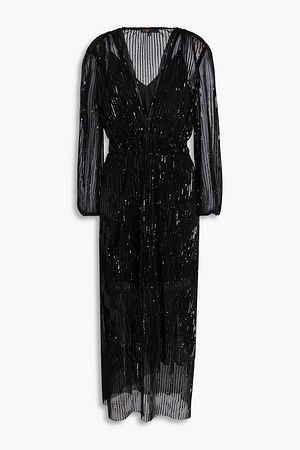The Icons - Little Black Dress
THE LBD
Author and style journalist, Katherine Ormerod, understands the power of the perfect little black dress. The discerning option for any dresscode, it has been continually reinvented for nearly a century, and used as a mark of refinement, rebellion and even revenge. But, as she reveals, there is a secret to getting it right – discover the styles to celebrate this holiday season.


Like any fashion-obsessed, Sex-and-the-City-addicted teenage girl living in the suburbs, I knew that my wardrobe was nothing without an LBD. Prowling my local mall for this elusive garment was the story of my youth; I so deeply believed that finding it would transform me into a sophisticated, mature woman of taste and refinement. And there were some successes - a hip-hugging midi worn for New Year’s Eve night at our local garage club (£50 a ticket, free drinks all night), or a Morgan De Toi spaghetti strap mini that I wore with pride on my first girls’ holiday. But it wasn’t until I got my proper editorial job as a fashion assistant at The Sunday Times Style that I truly understood the value of an LBD. Cut to taper the waist and just short enough to get away with on the tube, the first time I wore a Dolce & Gabbana lace LBD was a revelation. I immediately became the woman that I’d imagined for all those years – it was like clicking a switch.
Of course, the LBD had a long and storied heritage before my amateur attempts at channelling its majesty. The LBD, as we know it, debuted just under 100 years ago back in 1926. Before then, black was reserved exclusively for mourning and seen as a drab, draining shade, a world away from today’s ubiquity. But a subversive French designer, who went by the name of Coco Chanel, had a very different attitude to noir, colored by her childhood raised in a convent. Influenced by the nuns who taught her to sew, the young orphan Chanel saw the beauty and elegance of a monochromatic palette through their simple habits. She soon set about scandalizing society with her collection of spare, simple black dresses. In the midst of corsets and overbearing hats, the LBD became an emblem of rebellion.
Through the Great Depression, the little black dress provided a practical, good value way of expressing style, but post WWII, the staple was reinvented through the prism of Christian Dior’s New Look. Where Chanel’s designs always focused on liberating women to live active, participatory lives, the tiny nipped in waists and heavy, full pleats of Dior’s dresses switched the LBD glamour and femininity up to the max. Iconic LBDs followed decade by decade. In the 1960s, Hubert de Givenchy’s simple black sheath, as worn by Audrey’s Hepburn’s Holly Golightly in Breakfast at Tiffany’s, would go on to launch a million Ikea canvases, while Yves Saint Laurent provided the blueprint for the bourgeois jolie madame with Catherine Deneuve’s Belle du Jour LBD, finished exquisitely with a white silk collar and cuffs.

By the 1970s, the LBD went disco with Diana Ross sporting a sequin-bedecked ankle skimmer at Studio 54, while Jackie Kennedy showcased the power of chic chiffon to transform her LBD into an ultra-genteel ensemble as befitting a high society swan. Fast forward to the mid 1980s and Tina Turner proved the LBD had rock and roll appeal, wearing a club-inspired leather mini to perform with Mick Jagger at Live Aid. And 1994 was to prove a strong moment for the LBD as Princess Diana’s ‘revenge dress’, designed by Christina Stambolian vied with Elizabeth Hurley’s Versace safety-pin showstopper for dress of the year. That decade also birthed the spaghetti strap mini dress, which has already had so many renaissances that we can safely refer to it as a wardrobe staple. See Kate Moss, Carrie Bradshaw and Posh Spice for the full spectrum of style inspo.
The joy of the LBD today is that we have the chance to channel all of its incarnations, simply because it transcends trends. The LBD can be at once quiet, yet discerning, striking, yet appropriate for nearly every dress code. You can’t just have one, you need the whole catalogue. In terms of the modern, or on-trend way to wear an LBD, the key is to integrate it into your wardrobe to make it more sustainable and squeeze out as many wears as possible. Layer with knitwear, pop a fine turtleneck or bodysuit underneath it, pair with a white shirt or a chunky cardi. Never think you have to save an LBD for best.
As for what makes one LBD stand apart from another, the answer is always, always about the cut. With an absence of color or print, the margin for error in fit is completely obliterated. Your dress needs to fit like second skin, create an unusual and eye-catching proportion or simply showcase your favourite features with a décolletage-revealing scoop neckline or unexpectedly low back. It is all about design, quality of the fabric and sharp tailoring. Here, I’m wearing a forever LBD by Khaite. It doesn’t matter which season it stepped out on to the catwalk, it’s both incredibly simple, yet interesting enough with its high neckline and oval back cut out to rise to the top. It’s the kind of piece you would rescue from a burning house, the kind of piece I wouldn’t lend to a friend. When you find a good LBD, you do not let go.



